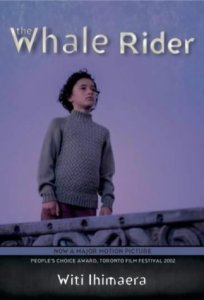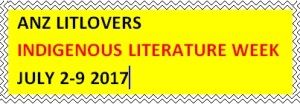 I remember the sense of excitement when we went to see The Whale Rider at the movies in 2002. The only other New Zealand film I’d seen was The Piano (1993), which was a great film but not, apart from the scenery, distinctively New Zealand in character because the characters were 19th century pioneers from Britain. The Whale Rider was my first introduction to Māori mythology and customs.
I remember the sense of excitement when we went to see The Whale Rider at the movies in 2002. The only other New Zealand film I’d seen was The Piano (1993), which was a great film but not, apart from the scenery, distinctively New Zealand in character because the characters were 19th century pioneers from Britain. The Whale Rider was my first introduction to Māori mythology and customs.
And now, over a decade later, I’ve finally read the book. A novella of 148 pages, The Whale Rider is Witi Ihimaera’s fourth work of fiction, and probably the best known. Like his other books it explores Māori culture in contemporary New Zealand, in this case, the crisis that occurs when the first-born to whom traditions are entrusted turns out to be a girl. However there are significant differences between the book and film, not just in the naming of characters but also in the plot. (Kahu is called Pai in the film). Re-reading the summary at Wikipedia I can see that dramatic tension has been escalated by characterising the girl as more confrontational than she is in the book.
The narration is mostly by Kahu’s older cousin Rawiri, from the generation that sees the wider world beckoning. As a teenager he observes his grandfather Koro’s rejection of Kahu because of her gender, and he admires his feisty grandmother Nanny Flowers who stands up to him. But as a young man he takes off to the bright lights of Sydney and then to labouring work in Papua New Guinea, returning home seven years later only when it is made clear that his mate’s mother doesn’t find him acceptable because of his colour. Rawiri is like a bridge between the generations, recognising that the world is different and some ways in the coastal village of Whangara must change but he is also keen to learn about his traditions and he’s a willing protector of customs. He’s a ‘manly’ man, physically strong and powerful on his motorbike, but even when a teenager he is not afraid to show that he has a tender side and nurtures his much younger cousin. He isn’t torn between his two warring grandparents: he loves and respects them both.
Rawiri also observes several instances where Kahu seems to have special powers. An omniscient narrator in the prologue tells the story of the ancient whales and how they came to communicate with humans, and it is this special relationship which is at risk because of Kahu’s gender. But it is Rawiri’s narration that reveals that Kahu is heard singing the whale’s song, and that it is she – not the boys chosen by Koro to take on the role – who is able to plunge to the depths to retrieve a stone cast by Koro. (The stone is a whale tooth in the film). The crisis comes when – the community having witnessed the deaths of 200 stranded whales not far from Whangara – a new stranding occurs and the bull whale defies all attempts to turn him around and lead the other whales out to sea. There is a pleasing inevitability about the way Kahu resolves the crisis and the life force of their community is restored. The Whale Rider isn’t a book to read for plot.
There are a lot of Māori words in this story, but the sentences are mostly crafted so that there is no need to consult the glossary at the back of the book. My edition also has photo stills from the film in a glossy centre-spread, which reminded me of some of the most vivid scenes: Kahu at a school ceremony bravely reciting her whakapapa (genealogy) although devastated that her grandfather has refused to attend, and the Māori men powering their canoe through the water at the end, demonstrating what a formidable force they must have been in the days when they were warriors.
The book or the film? I’m glad I had the vivid film images in my mind as I read, but I prefer the book.
Witi Ihimaera is of Ngati Tuwharetoa and Te Arawa descent. He was the first Māori author to be published in New Zealand.
 This is my third book for Indigenous Literature Week 2017.
This is my third book for Indigenous Literature Week 2017.
Author: Witi Ihimaera
Title: The Whale Rider
Publisher: Reed Publishing, 2002, first published 1987
ISBN: 9780790008691
Source: personal library, purchased from Brotherhood Books.
Availability
There were second-hand copies available at Fishpond on the day I looked: The Whale Rider but the novel is still in print and readily available in new editions.


I also watched the film when it first came out. For me it was extra exciting to see something from “down under.” Only a week or so ago I listened to the audiobook. Typically, they were different, I enjoyed each for different reasons. So nice to see your review about this title pop up today!
LikeLike
By: heidithedreamer on July 3, 2017
at 4:21 pm
The audio book sounds interesting… in the book, the passages that were about the legends of the whale were in Italics to signal a break in the contemporary narration. How did the narration do this signalling: in a different voice?
LikeLike
By: Lisa Hill on July 3, 2017
at 10:17 pm
The first NZ film I saw was a farce involving an old Vanguard car. I’ve seen The Piano and recently Hunt for the Wilderpeople, but not Whale Rider. Have you ever said the movie was better than the book?
LikeLike
By: wadholloway on July 3, 2017
at 7:06 pm
Hmmm, have I ever? *chuckle* I suspect not.
But there are some where they are complementary. I really liked the BBC series for War and Peace.
LikeLike
By: Lisa Hill on July 3, 2017
at 10:18 pm
[…] This review of The Whale Rider (ANZ Lit Lovers) […]
LikeLike
By: It’s Monday – Happy (almost) 4th of July! | Real Life Reading on July 4, 2017
at 12:01 am
[…] The Whale Rider, see my ANZ LitLovers review […]
LikeLike
By: Reviews from Indigenous Literature Week at ANZ Litlovers 2017 | ANZ LitLovers LitBlog on July 7, 2017
at 2:15 pm
[…] Māori author because of the popularity of The Whale Rider (1987) which was made into a film. (See my review of the novella). He has sixteen novels to his credit, including Bulibasha (1994) which I reviewed here. As the […]
LikeLike
By: The Uncle’s Story, by Witi Ihimaera | ANZ LitLovers LitBlog on July 13, 2019
at 9:01 am